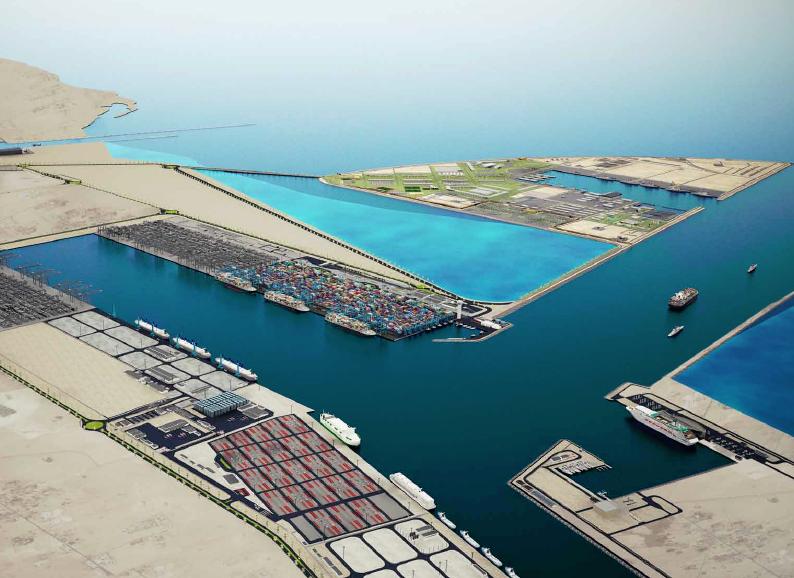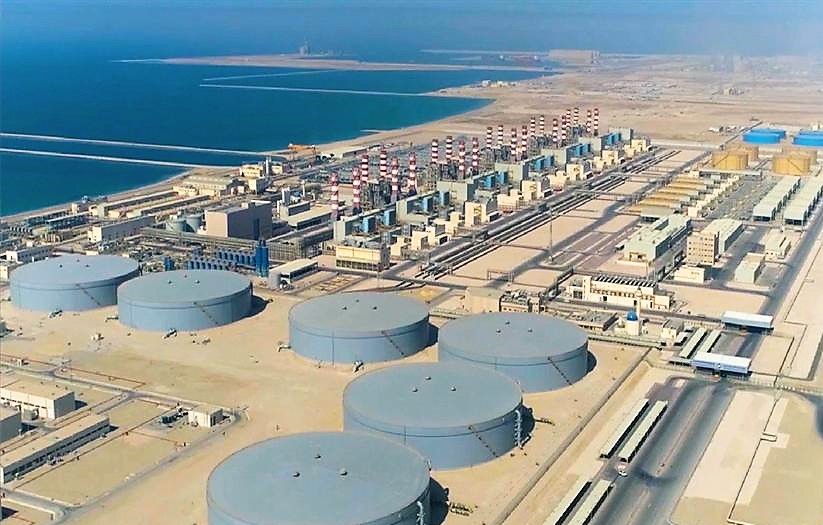
The New Port Project Steering Committee is tasked with the design and development of a port to meet the requirements of the Qatar National Vision 2030.
On 19 June 2007 His Highness Sheikh Hamad Bin Khalifa Al Thani, Emir of the State of Qatar, issued a decree to instigate one of the world's largest greenfield port developments. Strategically located south of Doha, the QAR 27 billion (US$7.4 billion) megaproject includes a new port, a new base for the Qatar Emiri Naval Forces and the Qatar Economic Zone 3, on a 26.5 square kilometre footprint.
The existing port had been operating above capacity for some time and its location did not fit with the long-term development plans of the State. The import of raw materials and goods required for the expansion plans envisaged in the Qatar National Vision 2030, along with the hosting of the FIFA World Cup in 2022, underscored the need for a new advanced commercial port facility.
In 2004 the State of Qatar commissioned a feasibility study to explore the relocation of the existing port. Seven sites were investigated prior to the current location being chosen. Work on the New Port Project site commenced in late 2008.
The new port will include world-class cargo and container terminals, cargo handling systems and in due course rail facilities that will link the port to the GCC region. Developed as a modern, efficient and cost competitive commercial port and characterized by state-of-the-art technologies, high quality service and minimized vessel delays, the new port is envisioned to become a preferred destination for the international shipping and maritime industry.
The New Port Project Steering Committee was established in June 2007 and immediately began to select a team of technically qualified industry and community leaders for its two guiding committees, the Tender Committee and the Technical Committee. Supported by a dedicated project team, the State’s vision is being brought to fruition by hundreds of individuals representing contractors and technical experts who are tasked with programme management, engineering design and environmental works.
The project commenced in 2008 with the award of the first contracts to the programme management consultant (AECOM) and the engineering design consultant (WorleyParsons). The environmental consultant contract was awarded to COWI in early 2009.
The first phase of the project is expected to be completed in 2016, and future phases will become operational as the need arises. Forecasts suggest that Qatar’s economy will continue growing at world-leading rates for the foreseeable future and the expansion of the State’s transportation facilities will support and fuel this growth. Container throughput, which in 2010 stood at approximately 350,000 TEU, is expected to increase to 2 million TEU by 2016, 4 million TEU by 2020 and 6 million TEU by 2030.
Once operational the new port will offer a comprehensive range of services for both shipping lines and cargo owners and investment in the required capital equipment and technology will be made to ensure client needs are met. ePM has been selected as the programme management information system (PMIS) and Info Exchange, a web-based platform, will be used to undertake and record SH&E inspections and observations of contractor performance.
From infrastructure such as piers and warehouses to equipment such as cranes, careful consideration has been given to fleet expansion and to the capital equipment requirements necessary to build the new port and then to ensure the requirements for modern port operations are in place.
For phase I of the port, eight ship-to-shore cranes will be delivered before the commencement of commercial operations in February 2016, and another four will be procured within 24 months of the first order. Twenty six rubber-tyred gantry (RTG) cranes will also be in place by February 2016, with another 12 to follow.
Contracts are divided into four types: infrastructure, marine, equipment and buildings. Local Qatari companies rated by the central tendering committee as ‘Class A’ contractors are eligible to tender for infrastructure and buildings contracts. For marine and equipment contracts, local and international companies are eligible to participate in the tendering exercise. Local companies can also participate in a joint venture, provided the Qatari company has at least 51 percent of the capital of the JV. For a local company to qualify, however, it must have acceptable cash flow, experience, equipment, skills, staff and commitment.
The new port will create significant legacy benefits in terms of developing the country’s human capital by facilitating the creation of numerous sustainable jobs, including a number of senior positions designated for Qatari nationals.
Innovation and continuous improvement, from increased railroad connectivity to streamlined policies and procedures related to security and customs, will be a fundamental aspect of the new port’s operations. World class systems, technologies and personnel will help achieve greater operations and cost efficiencies. The overarching objectives of meeting the needs of customers, growing the State’s economy and improving the region’s competitiveness as a trade hub are key aspects of master planning for the new port. Additionally, planning for continuous improvement will focus on minimizing adverse environmental impacts, economic diversification, sustainability and corporate social responsibility.
Sustainability is one of the cornerstones of master planning for the port. Working with a team of expert consultants has allowed the leadership of the New Port Project to ensure planning is comprehensive and that the correct resources are employed at the ‘right’ time. The concept of sustainability, and specifically incorporating sustainability into the design process, is a key component of the work tasked to the engineering design consultant.
The project is also using LEED (Leadership in Energy and Environmental Design) concepts for the design, construction and eventual operation of buildings and master planning has utilized many ‘green elements,’ including a focus on added walkways in order to make the facilities more pedestrian friendly and using ‘greywater’ (wastewater generated from domestic uses) for toilet flushing and landscaping in order to reduce the demand for more costly high-quality potable water.
Attracting and retaining highly skilled committee members has been essential to realising the goals and objectives established for the New Port Project. The work of the project’s committees is a vital element in achieving the ambitious expansion plans envisaged in the Qatar National Vision 2030. In turn, committee members are rewarded by the experience of being part of this significant project.
Written by Martin Ashcroft, research by Jon Bradley



 NewPort-MiddleEast.Trans-Jan13-Bro-s.pdf
NewPort-MiddleEast.Trans-Jan13-Bro-s.pdf









